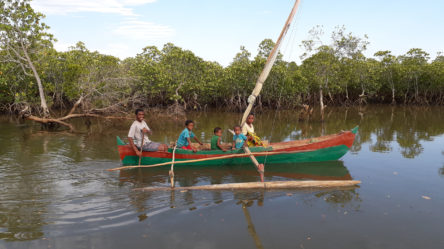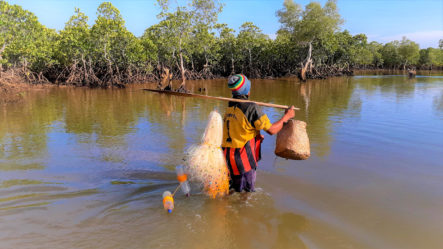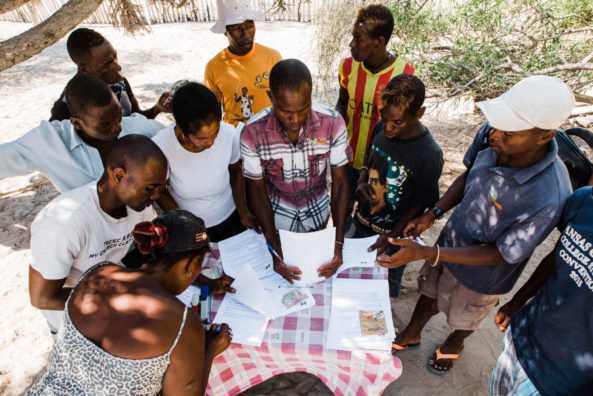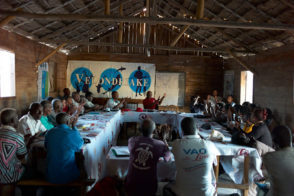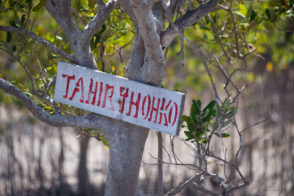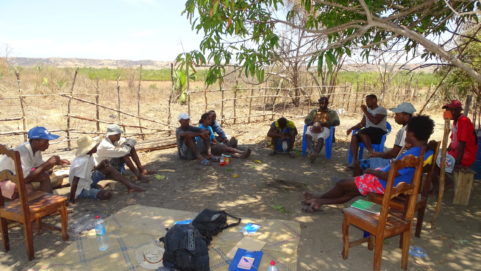This post is also available in:
 French
French
Our dry forest is vanishing. Our fishing resources are declining because of bad fishing practices. What we have left now is the mangrove forest. It is our future and the future of the next generations. So, even though I am old, with white hair, I will do my best to protect our wealth.”
In the village of Morangobe, southwest of Mahajamba Bay, Mr Tsimitrambogno, olobe (community leader) of the village and member of the fishers’ association, sums up a collective belief.
As the terrestrial forest is perpetually nibbled away by bushfires, the communities here are increasingly dependent on mangroves, which are vital for their livelihoods, as well as for maintaining Madagascar’s rich biodiversity. But due to illegal logging for charcoal and timber, the mangrove forest is also under threat.
Faced with these challenges, the communities here are working to manage their natural resources in a more sustainable way. To do this, they have two management tools at their disposal: dina, local customary law conventions that allow natural resource management measures to be put in place at the community level, and the transfer of mangrove management rights by the Malagasy state in favour of formalised community associations called VOI (Vondron’Olona Ifotony).
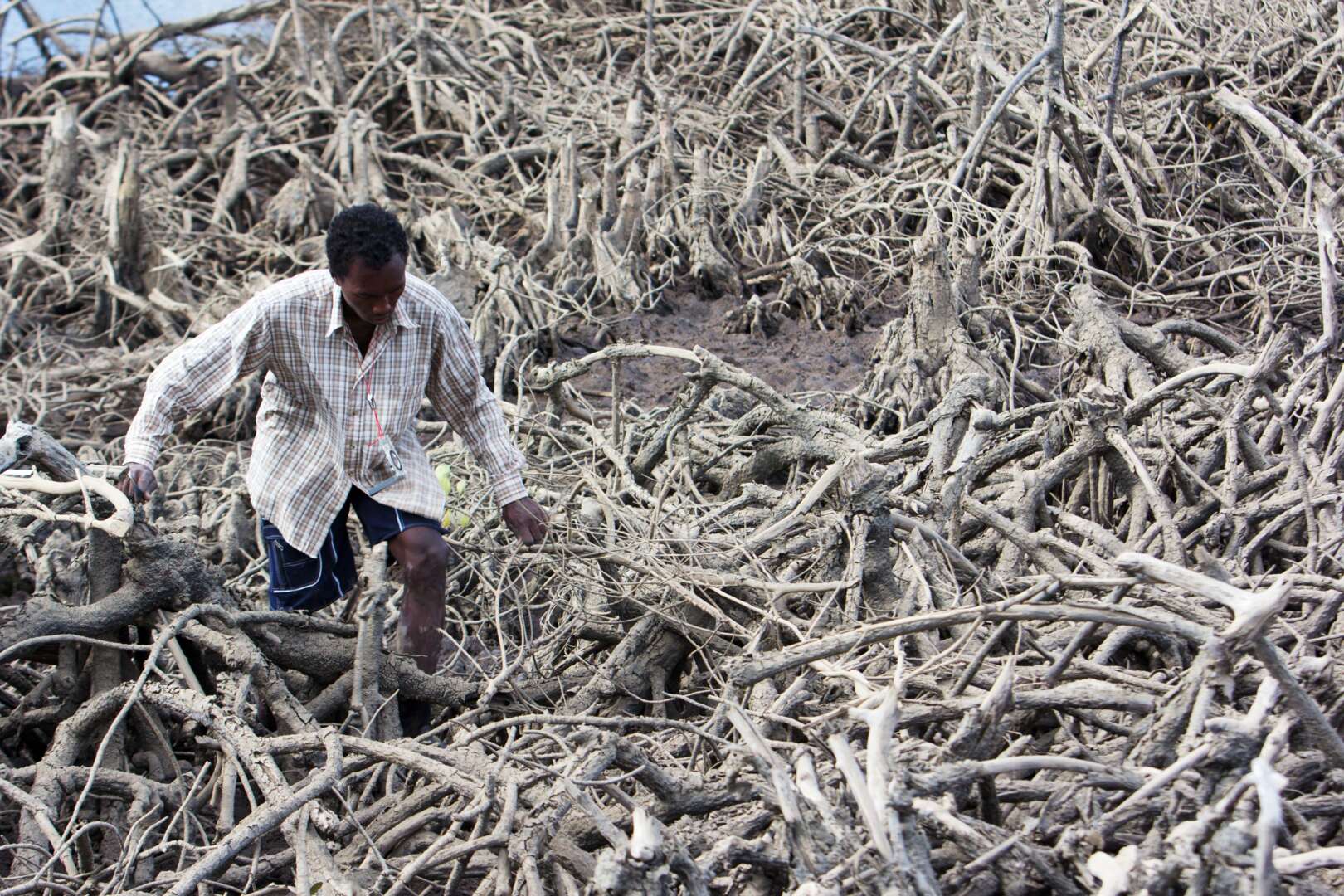
During my time working at Blue Ventures, I’ve sadly inspected and observed many areas of deforested mangroves | Photo: Garth Cripps
Sharing lessons learned
I have been working with small-scale fishing communities in northwest Madagascar for more than eight years. For a long time, I have supported community associations in Tsimipaika Bay, not far from the town of Ambanja, to establish their dina and management transfers. For the past year, I have been also responsible for supporting community governance in Mahajamba Bay, more than 700 kilometres away, where small-scale fishers from 14 villages have recently grouped into seven formalised associations.
I can now apply the lessons I have learned with the communities of Tsimipaika Bay to my work with the communities of Mahajamba Bay. Recently, I shared a story about my latest mission to Mahajamba Bay and explained the value of establishing early collaboration with both the local and administrative authorities for enabling sustainable, legitimate and recognised local management of marine resources by communities.
But there is another lesson that is absolutely essential: the entire community must be able to choose, adapt and establish its local management with full knowledge of the processes involved. This requires time, space for consultation, training for the people responsible for day-to-day management and, above all, exchanges of experience between fishers.
Guiding informed management processes
The processes involved in setting up dina, and even more so management transfers, are complex. It is essential to ensure that small-scale fishing communities understand the final objective of the process and are informed from the outset about each step along the way.The processes involved in setting up dina, and even more so management transfers, are complex. It is essential to ensure that small-scale fishing communities such as those in Mahajamba Bay – who live in remote areas, far from administrative centres with limited access to basic education – understand the final objective of the process and are informed from the outset about each step along the way. It is also necessary to make sure that the whole community is involved, to reduce any chance of disputes or conflicts.
To this end, our role is to support knowledge sharing sessions for the entire community, opportunities for direct exchanges with the authorities concerned, and a ‘Comité de discussion’ in each village, where olobe can support decision-making and stay informed. Most importantly, we share information on the functioning, role, responsibilities and objectives of VOIs.
A VOI could be set up in one day: you simply need to organise a community meeting, engage influential people from the community, and proceed to the vote of the President, Vice-President and Treasurer. But without cohesion and a common understanding of objectives, roles and responsibilities, the association would only exist on paper.
For a VOI to be robust, it is essential that communities develop all the necessary technical skills through a process of information sharing, consultation, training and practical learning over several years.
Changes in the bay
I have been to Mahajamba Bay several times, but on my last mission I was able to spend more time simply observing the fishers’ way of life, who live by the catch of the day. The only horizon of their villages is the dry forest, vulnerable to bushfires, and diminishing mangroves, under the pressure from illegal logging, cyclones and silting. Their fishing areas are congested by local fishers and fishers from elsewhere on the coast, all of whom are faced with an increasing scarcity of catches and too often resort to illegal fishing practices from a lack of sustainable solutions.
It touched me to hear them tell their stories, to listen to them share their suffering and their fears in the face of the increasing scarcity of their resources.During my visit, I went to the fishing village of Antsaregy, where I had a long discussion with a number of olobe. It touched me to hear them tell their stories, to listen to them share their suffering and their fears in the face of the increasing scarcity of their resources. It gave me hope when, after expressing their determination to fight to ensure the protection of these resources for future generations, the olobe told me about the next steps in the process: “We want to create a conservation area for mangroves and a reserve area for crabs. We are also looking forward to the next big step: the formalisation of our fishing and mangrove dina“, Tsimivogny, president of the Morangobe Fishers’ Association, summed up forcefully.
Between 2019 and 2020, the communities we partner with in Mahajamba Bay formalised seven fishers’ associations, which is an important step forward. Already, these associations: manage the fishing cards that are mandatory in any fishing area in Madagascar, ensure compliance with the law regarding national closures and legal fishing practices, manage minor conflicts, and raise awareness of all of these important aspects in their communities.
In a year and a half, since the creation of our fishers’ associations, we have already discussed many management measures that we would like to include in our dina, including the banning of talana (a very thin fishing net, which catches a lot of juveniles and is therefore very destructive). We have also submitted a letter to the north-western President of MIHARI, the locally managed marine areas network in Madagascar, to report violations of the fishing law to the Regional Directorate of Fishing,” says Papan’i Bolida, an adviser in the fishers’ association in the village of Antangena.
Over the past three years, the communities we have been supporting in Mahajamba Bay have acquired many of the skills and experience required to set up a VOI-type management structure. However, this technical support is only made valuable by the collective commitment from communities, which is most effectively inspired by the work of other associations through learning exchanges between fishers.
Visiting Velondriake
In the village of Antsaregy, when I was listening to the stories of the olobe, one name had come up several times: Velondriake. This is the name of the association managing Madagascar’s first locally managed marine area (LMMA), in the southwest of the country. Several of the olobe visited Velondriake in 2019 as part of an exchange visit about mangrove reserves. They were able to observe the Velondriake Association meetings and the community surveillance patrols in the mangroves, visit the fishing reserves, and meet with local small-scale fishers to discuss community-led management. By seeing and experiencing the operations, challenges and successes of another community working to protect their resources, the visitors from Mahajamba Bay gained a practical understanding of the benefits of local governance, as well as saw first-hand the commitment that’s required.
When they returned to the bay of Mahajamba, the olobe were able to tell their communities about the local management actions of the communities in Velondriake and discussed how to adapt what they saw to suit their local context. “If we can be as well organised as the Velondriake Association one day, I won’t be worried anymore about our resources in the future,” said Maman’i Liva, a member of the Andranoboka fishers’ association, who had participated in the visit.
The community had their very first reserve as a result of a decision of autonomous governance!Shortly afterwards, by reinforcing a fady (a traditional ban) through a ritual, the olobe declared that some islets in the bay were closed for crab and shrimp fishing. The community had their very first reserve as a result of a decision of autonomous governance!
Community-led scaling up
Whilst the complementary technical and administrative support provided by NGOs and partners is essential, peer-to-peer exchanges between fishers who face the same challenges offer the most effective practical guidance for communities who want to better manage their natural resources. Exchanges allow them to experience the day-to-day reality of establishing, operating and managing VOIs and most importantly, envisage a shared end goal.
In April 2021, the next exchange visit is planned, this time to Tsimipaika Bay. For the representatives of the communities of Mahajamba Bay, the objective will be threefold: to learn how the temporary closures of the mackerel fishery function, to draw inspiration from the commitment of the communities of Tsimipaika Bay to enforce dina fearlessly and, in return, to teach them the method of fish smoking.
This event will be the next in a growing series of fisheries learning exchanges happening across Madagascar, driving a scaling up of sustainable natural resource management models that is being led by the communities themselves.
Read part one of Zo’s story on building community-based governance in Mahajamba Bay




